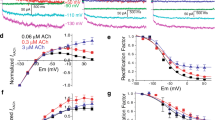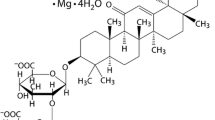Abstract
Tamoxifen (Tmx) is a nonsteroidal selective estrogen receptor antagonist and is frequently used in the treatment and prevention of breast cancer. The compound and its metabolites have been reported to inhibit functions of different classes of membrane proteins, including various ion channels. For members of the inward-rectifying K+ (Kir) channel family, interference of Tmx with binding of phosphatidylinositol 4,5-bisphosphate (PIP2) has been suggested as the mechanism underlying such inhibition. We have studied the inhibition of G protein-activated K+ (GIRK) current by Tmx in isolated myocytes from hearts of adult rats using whole-cell voltage clamp and experimental conditions for measuring K+ currents as inward currents (E K −50 mV; holding potential −90 mV). Extracellular Tmx reversibly inhibited GIRK current activated by acetylcholine (I K(ACh)) with an EC50 of 7.4 × 10−7 M. This inhibition was composed of two components, a basal reduction in peak current and a block that required opening of channels by ACh. The open-channel block was partially relieved by depolarizing voltage steps in a voltage- and time-dependent fashion. A voltage-dependent open-channel block was not observed when I K(ACh) was measured as outward current (E K −90 mV; holding potential −40 mV). Intracellular application of Tmx via the patch clamp pipette at a concentration (7 × 10−6 M) that caused a rapid inhibition of I K(ACh) upon extracellular application did not affect the current. Intracellular application of the H2O-soluble PIP2 analog diC8-PIP2 reduced the voltage-independent component of inhibition but had no effect on voltage-dependent open-channel block. The effects of 4-hydroxy-Tmx, a major active metabolite, tested at 2 × 10−6 M, had effects on I K(ACh) analogous to those of Tmx. Inhibition of constitutive inward-rectifying K+ current (I K1) in ventricular myocytes, carried by Kir2 complexes, by Tmx was devoid of a voltage-dependent component. This study suggests the voltage-dependent open-channel block of GIRK inward current as a novel mechanism of Tmx action.










Similar content being viewed by others
References
Ali S, Buluwela L, Coombes RC (2011) Antiestrogens and their therapeutic applications in breast cancer and other diseases. Annu Rev Med 62:217–232
Anumonwo JM, Lopatin AN (2010) Cardiac strong inward rectifier potassium channels. J Mol Cell Cardiol 48:45–54
Beckmann C, Rinne A, Littwitz C, Mintert E, Bösche LI, Kienitz MC, Pott L, Bender K (2008) G protein-activated (GIRK) current in rat ventricular myocytes is masked by constitutive inward rectifier current (I K1). Cell Physiol Biochem 21:259–268
Bender K, Wellner-Kienitz MC, Inanobe A, Meyer T, Kurachi Y, Pott L (2001) Overexpression of monomeric and multimeric GIRK4 subunits in rat atrial myocytes removes fast desensitization and reduces inward rectification of muscarinic K+ current (I K(ACh)). J Biol Chem 276:28873–28880
Borgna JL, Rochefort H (1981) Hydroxylated metabolites of tamoxifen are formed in vivo and bound to estrogen receptor in target tissues. J Biol Chem 256:859–868
Brandts B, Brandts A, Wellner-Kienitz MC, Zidek W, Schlüter H, Pott L (1998) Non-receptor-mediated activation of I K(ATP) and inhibition of I K(ACh) by diadenosine polyphosphates in guinea-pig atrial myocytes. J Physiol 512:407–420
Cha TJ, Ehrlich JR, Chartier D, Qi XY, Xiao L, Nattel S (2006) Kir3-based inward rectifier potassium current: potential role in atrial tachycardia remodeling effects on atrial repolarization and arrhythmias. Circulation 113:1730–1737
Cho H, Lee D, Lee SH, Ho WK (2005) Receptor-induced depletion of phosphatidylinositol 4,5-bisphosphate inhibits inwardly rectifying K+ channels in a receptor-specific manner. Proc Natl Acad Sci USA 102:4643–4648
Dick GM, Rossow CF, Smirnov S, Horowitz B, Sanders KM (2001) Tamoxifen activates smooth muscle BK channels through the regulatory β1 subunit. J Biol Chem 276:34594–34599
Dobrev D, Wettwer E, Kortner A, Knaut M, Schüler S, Ravens U (2002) Human inward rectifier potassium channels in chronic and postoperative atrial fibrillation. Cardiovasc Res 54:397–40s4
Dobrev D, Friedrich A, Voigt N, Jost N, Wetter E, Christ T, Knaut M, Ravens U (2005) The G protein-gated potassium current IK, ACh is constitutively active in patients with chronic atrial fibrillation. Circulation 112:3697–3706
El Gebeily G, Fiset C (2010) 4-Hydroxytamoxifen inhibits K+ currents in mouse ventricular myocytes. Eur J Pharmacol 629:96–103
El Gebeily G, Fiset C (2011) Upregulation of ventricular potassium channels by chronic tamoxifen treatment. Cardiovasc Res 90:68–76
Hamill OP, Marty A, Neher E, Sakmann B, Sigworth FJ (1981) Improved patch clamp techniques for high-resolution current recording from cells and cell-free membrane patches. Pflügers Arch 391:85–100
Hardy SP, deFelipe C, Valverde MA (1998) Inhibition of voltage-gated cationic channels in rat embryonic hypothalamic neurones and C1300 neuroblastoma cells by triphenylethylene antioestrogens. FEBS Lett 434:236–240
He J, Kargacin ME, Kargacin GJ, Ward CA (2003) Tamoxifen inhibits Na+ and K+ currents in rat ventricular myocytes. Am J Physiol Heart Circ Physiol 285:H661–H668
Hertel F, Switalski A, Mintert-Jancke E, Karavassilidou K, Bender K, Pott L, Kienitz MC (2011) A genetically encoded tool kit for manipulating and monitoring membrane phosphatidylinositol 4,5-bisphosphate in intact cells. PLoS One 6:e20855
Hibino H, Inanobe A, Furutani K, Murakami S, Findlay I, Kurachi Y (2010) Inwardly rectifying potassium channels: their structure, function, and physiological roles. Physiol Rev 90:291–366
Huang CL, Feng S, Hilgemann DW (1998) Direct activation of inward rectifier potassium channels by PIP2 and its stabilization by Gβγ. Nature 391:803–806
Kienitz MC, Littwitz C, Bender K, Pott L (2011) Remodeling of inward rectifying K+ currents in rat atrial myocytes by overexpression of A1-adenosine receptors. Basic Res Cardiol 106:953–966
Kofuji P, Newman EA (2004) Potassium buffering in the central nervous system. Neuroscience 129:1045–1056
Liu XK, Katchman A, Ebert SN, Woosley RL (1998) The antiestrogen tamoxifen blocks the delayed rectifier potassium current, I Kr, in rabbit ventricular myocytes. J Pharmacol Exp Ther 287:877–883
Lopes CM, Zhang H, Rohacs T, Jin T, Yang J, Logothetis DE (2002) Alterations in conserved Kir channel-PIP2 interactions underlie channelopathies. Neuron 34:33–944
Lüscher C, Slesinger PA (2010) Emerging roles for G protein-gated inwardly rectifying potassium (GIRK) channels in health and disease. Nat Rev Neurosci 11:301–315
Meyer T, Wellner-Kienitz MC, Biewald A, Bender K, Eickel A, Pott L (2001) Depletion of phosphatidylinositol 4,5 bisphosphate by activation of PLC-coupled receptors causes slow inhibition but not desensitisation of GIRK current in atrial myocytes. J Biol Chem 276:5650–5658
Pollack IF, DaRosso RC, Robertson PL, Jakacki RL, Mirro JRJ, Blatt J, Nicholson S, Packer RJ, Allen JC, Cisneros A, Jordan VC (1997) A phase I study of high-dose tamoxifen for the treatment of refractory malignant gliomas of childhood. Clin Cancer Res 3:1109–1115
Ponce-Balbuena D, Lopez-Izquierdo A, Ferrer T, Rodriguez-Menchaca AA, Arechiga-Figueroa IA, Sanchez-Chapula JA (2009) Tamoxifen inhibits inward rectifier K+2.x family of inward rectifier channels by interfering with phosphatidylinositol 4,5-bisphosphate channel interaction. J Pharmacol Exp Ther 331:563–573
Ponce-Balbuena D, Moreno-Galindo EG, Lopez-Izquierdo A, Ferrer T, Sanchez-Chapula JA (2010) Tamoxifen inhibits cardiac ATP-sensitive and acetylcholine-activated K+ currents in part by interfering with phosphatidylinositol 4,5-bisphosphate-channel interaction. J Pharmacol Sci 113:66–75
Robbins J, Marsh SJ, Brown DA (2006) Probing the regulation of M (Kv7) potassium channels in intact neurons with membrane-targeted peptides. J Neurosci 26:7950–7961
Slovacek L, Ansorgova V, Macingova Z, Haman L, Petera J (2008) Tamoxifen-induced QT interval prolongation. J Clin Pharm Ther 33:453–455
Sui JL, Petit-Jacques J, Logothetis DE (1998) Activation of the atrial KACh channel by the βγ subunits of G proteins or intracellular Na+ ions depends on the presence of phosphatidylinositol phosphates. Proc Natl Acad Sci USA 95:1307–1312
Thomas D, Gut B, Karsai S, Wimmer AB, Wu K, Wendt-Nordahl G, Zhang W, Kathöfer S, Schoels W, Katus HA, Kiehn J, Karle CA (2003) Inhibition of cloned HERG potassium channels by the antiestrogen tamoxifen. Naunyn Schmiedeberg‘s Arch Pharmacol 368:41–48
Trump DL, Smith DC, Ellis PG, Rogers MP, Schold SC, Winer EP, Panella TJ, Jordan VC, Fine RL (1992) High-dose oral tamoxifen, a potential multidrug-resistance-reversal agent: phase I trial in combination with vinblastine. J Natl Cancer Inst 84:1811–1816
Voigt N, Trausch A, Knaut M, Matschke K, Varro A, Van Wagoner DR, Nattel S, Ravens U, Dobrev D (2010) Left-to-right atrial inward rectifier potassium current gradients in patients with paroxysmal versus chronic atrial fibrillation. Circ Arrhythm Electrophysiol 3:472–480
Yamada M (2002) The role of muscarinic K+ channels in the negative chronotropic effect of a muscarinic agonist. J Pharmacol Exp Ther 300:681–687
Yamada M, Kurachi Y (1995) Spermine gates inward-rectifying muscarinic but not ATP-sensitive K+ channels in rabbit atrial myocytes. J Biol Chem 270:9289–9294
Yuill KH, Borg JJ, Ridley JM, Milnes JT, Witchel HJ, Paul AA, Kozlowski RZ, Hancox JC (2004) Potent inhibition of human cardiac potassium (HERG) channels by the anti-estrogen agent clomiphene—without QT interval prolongation. Biochem Biophys Res Commun 318:556–561
Zhang Y, Riesterer C, Ayrall AM, Sablitzky F, Littlewood TD, Reth M (1996) Inducible site-directed recombination in mouse embryonic stem cells. Nucleic Acids Res 24:543–548
Zitron E, Kiesecker C, Luck S, Kathöfer S, Thomas D, Kreye VA, Kiehn J, Katus HA, Schoels W, Karle CA (2004) Human cardiac inwardly rectifying current I Kir2.2 is upregulated by activation of protein kinase A. Cardiovasc Res 63:520–527
Acknowledgments
We wish to thank Anke Galhoff and Bing Liu for excellent technical assistance. This work was supported by FoRUM (F-658-2009) and Deutsche Stiftung für Herzforschung (F/1407).
Conflict of interest
The authors declare that they have no conflict of interest.
Author information
Authors and Affiliations
Corresponding author
Rights and permissions
About this article
Cite this article
Vanheiden, S., Pott, L. & Kienitz, MC. Voltage-dependent open-channel block of G protein-gated inward-rectifying K+ (GIRK) current in rat atrial myocytes by tamoxifen. Naunyn-Schmiedeberg's Arch Pharmacol 385, 1149–1160 (2012). https://doi.org/10.1007/s00210-012-0801-8
Received:
Accepted:
Published:
Issue Date:
DOI: https://doi.org/10.1007/s00210-012-0801-8




